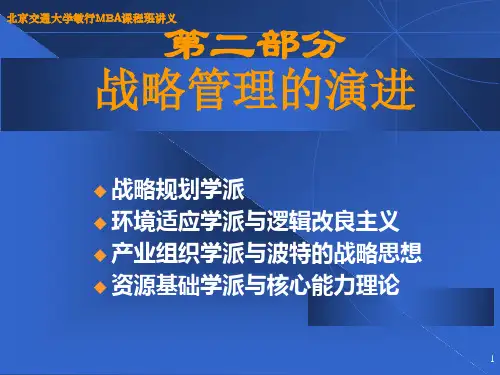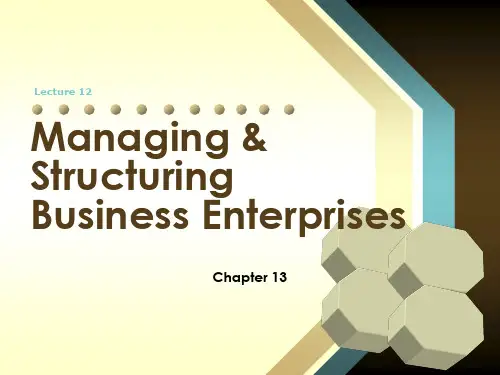business strategy企业战略管理英文版(上海财经大学 董静)
- 格式:ppt
- 大小:6.19 MB
- 文档页数:173
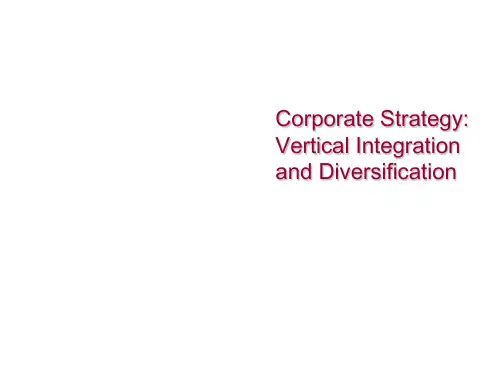

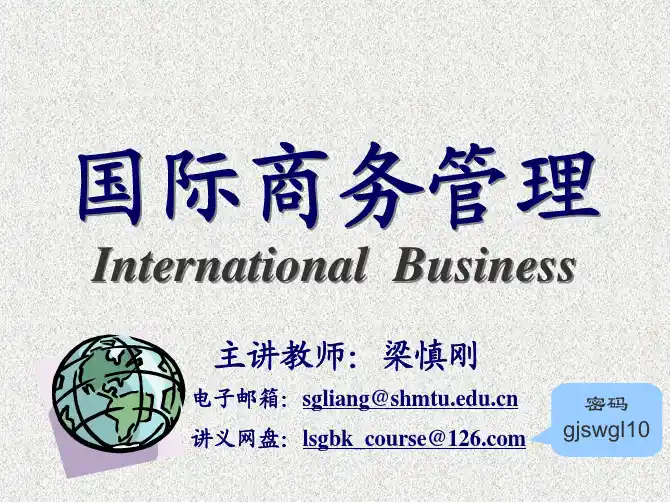
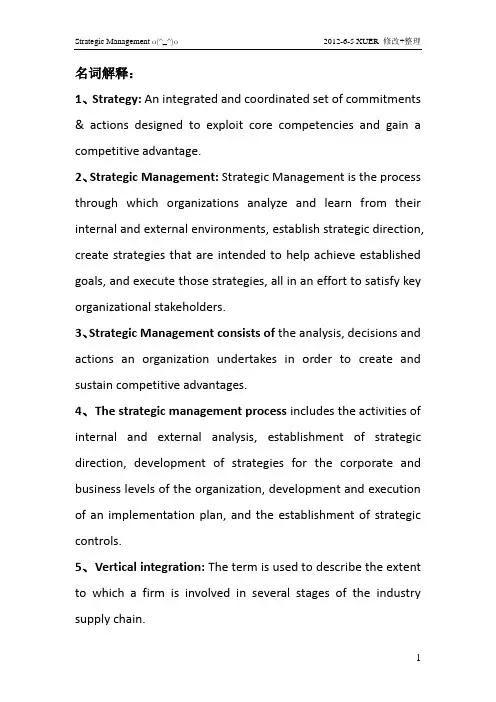
名词解释:1、Strategy: An integrated and coordinated set of commitments & actions designed to exploit core competencies and gain a competitive advantage.2、Strategic Management: Strategic Management is the process through which organizations analyze and learn from their internal and external environments, establish strategic direction, create strategies that are intended to help achieve established goals, and execute those strategies, all in an effort to satisfy key organizational stakeholders.3、Strategic Management consists of the analysis, decisions and actions an organization undertakes in order to create and sustain competitive advantages.4、The strategic management process includes the activities of internal and external analysis, establishment of strategic direction, development of strategies for the corporate and business levels of the organization, development and execution of an implementation plan, and the establishment of strategic controls.5、Vertical integration: The term is used to describe the extent to which a firm is involved in several stages of the industry supply chain.6、Horizontal integration: The process of acquiring or merging with industry competitors to achieve the competitive advantages that arise from a large size and scope of operations.7、Diversification strategy describes the scope of the firm in terms of the industries and markets in which it competes.8、Related diversification implies organizational involvement in activities that are somehow related to the dominant or “core” business of the organization, often through common markets or similar technologies.9、Unrelated diversification does not depend on any pattern of relatedness. Unrelated diversification has lower profitability and higher risks than those pursuing other corporate-level strategies such as concentration or related diversification.10、Organizational fit: When two organizations or business units are merged or acquisition happened, and the organizational management processes, cultures, system, and structures are matching(similar), this is organizational fit.11、Marketing strategy: Marketing strategy is the plan for investing marketing efforts and resources (advertising, branding, distribution, etc.)to achieve business goals.To support growth strategiesTo support a stability or retrenchment strategy12、Economies of scale: Economies of scale refers to the cost advantages that an enterprise obtains due to expansion. There are factors that cause a producer’s average cost per unit to fall as the scale of output is increased. "Economies of scale" is a long run concept and refers to reductions in unit cost as the size of a facility and the usage levels of other inputs increase.(1)Economies of scale. Unit cost reductions associated with a large scale of output •Larger production runs•Larger facilities•Allocating fixed costs(2)Diseconomies of scale. Unit cost increases associated with a large scale of output•Increased bureaucracy associated with large-scale enterprises•Resulting managerial inefficiencies13、True economies of scale are cost advantages associated with large-sized facilities rather than with increased volume through an existing facility.14、Life cycle of an industry: Refers to the stages of Introduction, Growth, Maturity and Decline, portrays how salesvolume for a product or an entire industry changes over its lifetime and helps to understand the dynamic nature of strategy.15、So-called product life cycle: Refers to the product from entering the market ,the market cycle, until final out of the market experience.简答论述:一、潜在竞争者出现面临的障碍都有哪些障碍并举例(Potential competitors∕Entry Barriers P31)Potential competitors∕Entry Barriers: Forces that keep new entrants out, providing a level of protection for existing competitors, are called entry barriers.Examples of entry barriers commonly found in many industries include the following:1、Economies of scale, which occur when it is more efficient to produce a product in a large facility at higher volume.2、Large capital requirements,also known as start-up costs ,can prevent a small competitor from entering an industry.3、High levels of products differentiation ,which means that some firms enjoy a loyal customer base, making it harder for a new firm to draw away customers.4、High switching costs ,applying not only to suppliers, can be used to preserve established firms in an industry.5、Limited access to distribution channels,which may prevent new companies from getting their products to market.6、Government policies and regulations that limit entry into industry,effectively preventing new competition.7、Existing firm procession of resources that are difficult to duplicate in the short term. Such as patents, favorable locations, proprietary product technology, government subsidies, or access to scarce raw materials.(Cost disadvantages independent of scale)8、A past history of aggressive retaliation by industry competitors toward new entrants.(Threat of new entries)二、什么样资源、能力能使企业形成持续核心竞争力?(Sustainable competitive advantage P46 )Internal resources and capabilities fall into five: human, physical, financial, knowledge, and organizational.In general, capabilities and resource become strengths with the potential to create a competitive advantage if two conditions are met.1.The resource or capabilities are value.2.The resource or capabilities are unique.In addition, a unique and valuable resources or capability actually becomes a competitive advantage if the following additional conditions are met:1.The organization is suited to exploitation of the resourceor capability.2.T he firm’s managers are aware of the potential of theresource or capability to lead to a competitive advantageand have taken steps to realize the advantage.Finally, a resource or capability can be a source of sustainable competitive advantage if two additional conditions are met:1.The resource or capabilities are difficult or expensive to imitate.2.No readily available substitutes exist.三、企业的社会责任感的概念以及包含哪些重点内容?(Social responsibility P15上课补充的)Social responsibility:the expectation that businesses or individuals will strive to improve the overall welfare of society.1、Economic responsibility. Such as the obligation to beproductive and profitable and meet the consumer needs of society.2、Legal responsibility.To achieve economic goals withinthe confines of established laws.3、Moral obligations. To abide by unwritten codes, norms,and values implicitly derived from society.4、Discretionary responsibility. Volitional or philanthropicin nature.四、怎么实现低成本战略?How to Realize the Low-costStrategy (Cost leadership P95)Low-cost leadership allows a firm to compete by lowering prices when needed without becoming unprofitable.Firms pursuing a low-cost strategy will typically employ one or more of the following factors to create their low-cost position:1.High capacity utilization.When customer demand is highand the firm’s capacity is full utilized, fixed costs are spread over more units, lowering unit cost.2.Economic of scale. True economies of scale are costadvantages associated with large-sized facilities rather than with increased volume through an existing facility.3.Technological panies making investments incost-saving technologies are often trading an increase in fixed costs for a reduction in variable costs.4.Learning/experience effects.The learning curve effect saysthat the time required to complete a task will decrease as a predictable function of the number of times the task is repeated.Experience effects are the same thing as learning effects but relate to indirect labor as well as direct production labor.五、功能性(职能)战略的概念,发展比较好应具备什么特点?(Functional strategies P137)Functional strategies: Functional strategies are the plans for matching those skills, resources, and capabilities to the business and corporate strategies of the organization.The well-developed Functional strategies should have the following Characters:1.Decisions made within each function will be consistent with each other.2.Decisions made within one function will be consistent with those in other functions.3.Decisions made within functions will be consistent with the strategies of the business.六、改善组织学习质量、提高组织学习数量,控制系统应该具备什么特征?(To enhance the quality of organizational learning ,these control systems should have the following characters )a) Information generated by the control system should be an important and recurring item to be addressed by the highest levels of management.b) The control process should also be given frequent and regular attention from operating managers at all levels of the organization.c) Data from the system should be interpreted and discussed inface-to-face meeting among superiors and subordinates.d) The success of the control process relies on the continual challenge and debate of underlying data, assumptions, and strategies.小论文:多元化战略,结合实际认识,优缺点,对企业发展的影响。
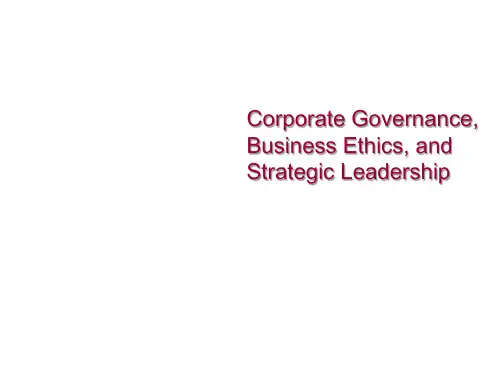
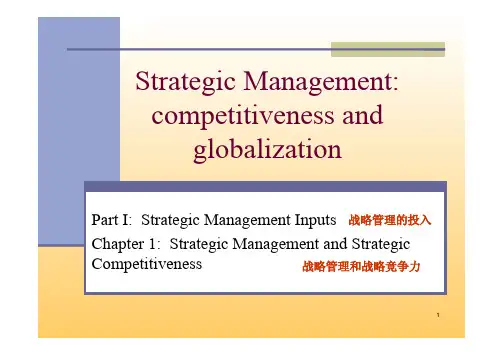
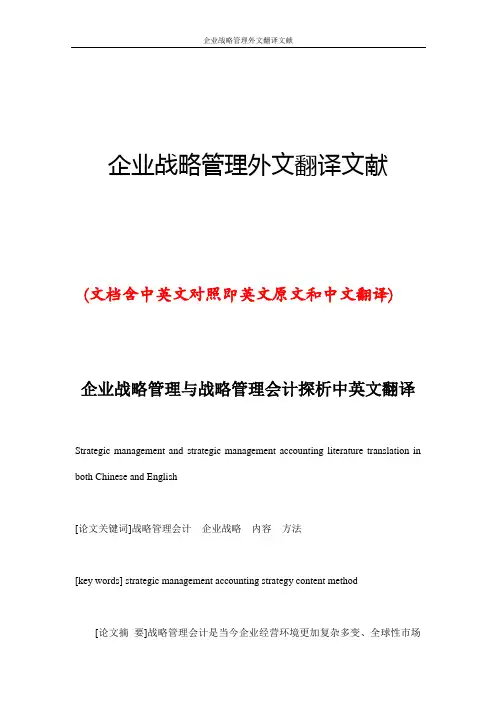
企业战略管理外文翻译文献(文档含中英文对照即英文原文和中文翻译)企业战略管理与战略管理会计探析中英文翻译Strategic management and strategic management accounting literature translation in both Chinese and English[论文关键词]战略管理会计企业战略内容方法[key words] strategic management accounting strategy content method [论文摘要]战略管理会计是当今企业经营环境更加复杂多变、全球性市场竞争空前广泛激烈的情况下,为满足现代企业实施战略管理的特定信息需要而建立的新的管理会计信息系统。
本文从战略管理会计的内涵、目标及特点阐述到战略管理会计的主要内容和方法对战略管理会计进行论述。
/ paper pick to strategic management accounting is the enterprise management environment is more complex, an unprecedented high competitive global market, to meet the modern enterprise to implement strategic management specific information need and establish a new management accounting information system. This article from connotation, goals and characteristics of strategic management accounting to the main content of strategic management accounting and methods of strategic management accounting in this paper.一、从企业战略的高度来看战略管理会计One, from the perspective of the height of business strategy, strategic management accounting1981年,英国学者西蒙斯最早将管理会计与战略管理相结合,提出战略管理会计之说。
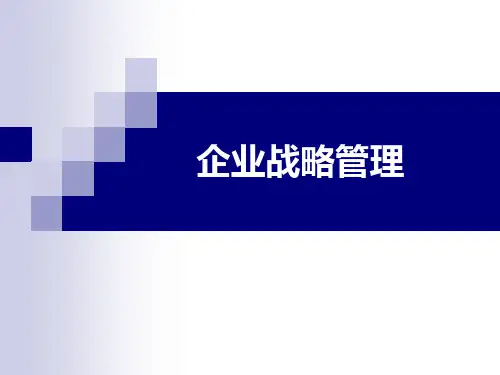

战略管理双语资料(共71页)--本页仅作为文档封面,使用时请直接删除即可----内页可以根据需求调整合适字体及大小--Chapter 1 Strateg ic Ma n a gem e nt a nd Str a tegic Com pe titiven e ss ................... 错误!未定义书签。
Management Process .............................................................................. 错误!未定义书签。
The Rational Model ....................................................................... 错误!未定义书签。
The critique of the rational model .................................................. 错误!未定义书签。
The New Competitive Landscape ........................................................... 错误!未定义书签。
Globalized Competition ................................................................. 错误!未定义书签。
Changes .......................................................................................... 错误!未定义书签。
I/O model of Above-average Returns ..................................................... 错误!未定义书签。
